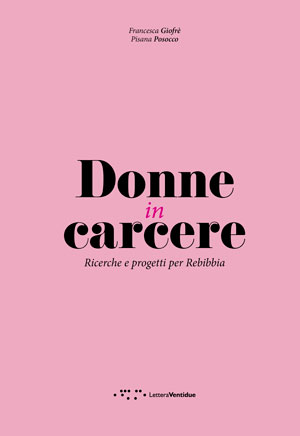
Inhabiting the prison.
Design proposals for the female body
«Prison is a place for living, rehabilitation and socialization»1:
this is the assumption behind the proposal by Francesca Giofrè
and Pisana Posocco, collected in "Women in prison. Research and
projects for Rebibbia", a book published by LetteraVentidue in the
series "Alleli", dedicated to research.
The book deals with the spaces dedicated to women prisoners. Women in
prison are a minority within the minority underrepresented and often
ignored2,
because, like most places, prison is historically thought and designed
for men. In order to understand women prisoners, it is strictly
necessary to physically access their spaces, just as in order to design
them, it is necessary to understand their invisible world of rhythms
and ways of life. The two authors entered the women's prison with the
respect required when entering someone else's home and this volume
guide us through it.
The publication is the result of a research funded by Sapienza
University in 2018. The book’s structure mirrors a clear
methodological approach, aimed at verifying of the possibilities of
intervention on existing spaces. The research does not offer further
typological models. Instead, the architectural theme of the prison is
originally approached as a project of analysis and recovery of the
heritage in use. This concrete approach derives from the cooperation
with the women’s Casa Circondariale of the Rebibbia prison and
from the constant collaboration with the Department of Penitentiary
Administration.
In the first part of the volume, the authors and Letizia Gorgo, PhD and
member of the working group, address the relationship between the
prison’s institution, its spaces and the lives of women
prisoners. The study is led on three levels: through a historical and
critical recognition of spatial models, through official data analysis
and through the study of the interviews with prisoners.
These premises defines the design operational guidelines for the
interventions at Rebibbia, illustrated in the second part of the book.
Practice occupies, not by chance, half of the publication: from the
arrangement, realized, of the Orchidea detention wing for working
inmates, to the proposals of the thesis workshops, ranging from
architectural redevelopment to product design, up to the construction
of the M.A.MA., a small building for family gatherings built within a
green area of the prison as part of Renzo Piano’s G124 program
3.
This book proves that academic research can have important practical
impact: it is possible by entering on tiptoe into an enclosed and
complex cosmos, intervening on the built environment with humility and
a considered lightness. This approach emerges even from the beautiful
pastel pink book’s cover, it’s no coincidence if it
resembles themes emerged in the interviews with the prisoners. It
refers to the possibility of giving physical body to immaterial needs,
such as recognizing a space as one's own. The research thus seems to
work on the relationship between two bodies, that of the existing
prison and that of the inmates, based on mutual care.
The direct involvement of the users, both in the process of
investigation and of intervention is substantial in shifting the gaze
on the cell from a punitive space to a space of life. If
depersonalization is one of the strongest violence felt by the inmates
and the deprivation of liberty is the only real punishment to be
served, in this regard, in Italian prisons, there is still much work to
be done. However, the book asserts an optimistic confidence that change
can also come about through taking care of the little things. It is not
a matter of finding extra square meters, but of making existing
surfaces ‘three-dimensional’, responding to needs that
might seem trivial but are often ignored. The material translation of
these needs requires a specific and trained sensitivity of the
interpreter-architect, who responds with light, air, sounds, colours,
visuals. As it unfolds, space allows the prisoners-inhabitants to
«tame the places and to recognize their value»4, hence finding a home in them.
Irene Romano
Note1 F. Giofrè e P. Posocco, Donne in carcere. Ricerche e progetti per Rebibbia, LetteraVentidue, Siracusa 2020, p. 13.
2 Women form the 4% of all the italian prisoners. However, this percentage does not consider gender identity: being imprisoned in a male or female institute depends on wich sex is acknowledged by identity documents. For instance, trans women with male reproductive organs are directed in male prisons.
3 Pisana Posocco worked at the project with the architects Tommaso Marenaci, Attilio Mazzetto and Martina Passeri, publicly selected for the 2019 edition of G124. For further information: “Diario delle periferie 2019. G124, Renzo Piano al Senato”, edited by S. Pellizzari, LetteraVentidue, Siracusa 2020.
4 P. Posocco, Abitare in carcere. La cella e lo spazio tra le celle, in F. Giofrè e P. Posocco, cit. p. 94.
Title: Donne in carcere
Subtitle: Ricerche e progetti per Rebibbia
Language: italian
Publisher: LetteraVentidue
Characteristic: 16,5x24cm, 288 pages, paperback, colours
ISBN: 9788862425056
Year: 2020